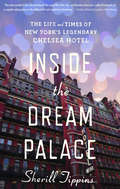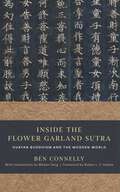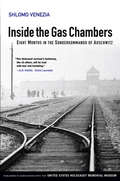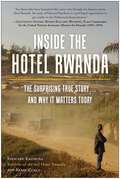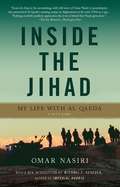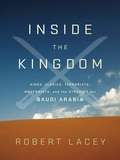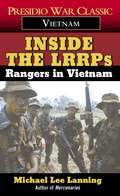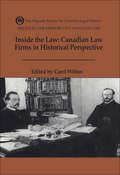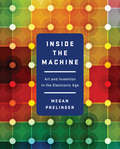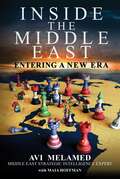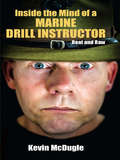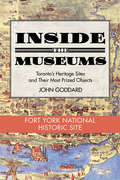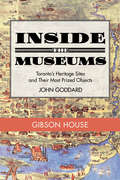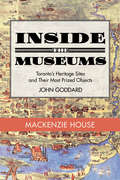- Table View
- List View
Inside the Dream Palace: The Life and Times of New York's Legendary Chelsea Hotel
by Sherill TippinsWinner of the National Award for Arts Writing: &“If there were a course in Chelsea Hotel-iana, this would be the textbook&” (The New York Times). It&’s where Dylan Thomas lived his last days, Bob Dylan wrote Blonde on Blonde, and Arthur C. Clarke wrote 2001: A Space Odyssey. It is memorialized by many of its famous inhabitants: Andy Warhol filmed Chelsea Girls there, and Leonard Cohen wrote Chelsea Hotel #2 about his tryst with Janis Joplin. Since its founding by a utopian-minded French architect in 1884, New York&’s Chelsea Hotel has been a hotbed of artistic invention and inspiration. Cultural luminaries from Sid Vicious to Thomas Wolfe, Edith Piaf to Patti Smith, Jean-Paul Sartre to Dee Dee Ramone—all made the Chelsea the largest and longest-lived artist community in the world. Inside the Dream Palace tells the hotel&’s story, from its earliest days as a cooperative community, through its pop art, rock-and-roll, and punk periods, to its later transformations under new ownership. With this lively and fascinating history, &“Tippins tells riveting stories about the Chelsea&’s artists, but she also captures a much grander, and more pressing, narrative: that of the ongoing battle between art and capitalism in the city&” (The New Yorker). &“An inspired investigation into the utopian spirit of the Chelsea Hotel.&” —Elle &“An impossible order for any writer: Get the Chelsea&’s romance down on paper and try to keep up with Patti Smith and Joni Mitchell and Arthur Miller. But Sherill Tippins&’s history does a vivid job of taking you up into those seedy, splendid hallways, now gone forever.&” —New York magazine &“Tippins succeeds where other historians studying New York landmarks have failed: She understands that even the most splendid buildings are mere settings for the personalities that inhabit them, and wisely bypasses rote chronology for the vigor of cultural excavation.&” —Time Out New York &“Not only essential to the understanding of this crucial New York City—and therefore American—cultural landmark, but as majestic and populous as the edifice itself, and completely entertaining.&” —Daniel Menaker, author of My Mistake
Inside the Expressive Culture of Chinese Women's Mosques: ‘This Turmoil of the Soul’ (ISSN)
by Maria JaschokThis book presents a multi-voice narrative of the history and significance of current contestations over the increasing prominence of expressive piety in Hui Muslim women’s mosques in central China. By drawing on a ‘Song Book’ of chants, collected from the tradition of women’s mosques, as context it reveals just how the increasing prominence of female voices has given rise to considerable misgivings among senior religious leaders over the potential destabilization of orthodox Islamic gendered practices. Providing a historical introduction to the place and function of Islamic chants, jingge and zansheng, the book gives a conceptual framing of female silence, sound, and agency in local translations of Confucian and Islamic precepts, and women’s personal accounts of the role played by traditional and modern soundscapes in transmitting and celebrating Islamic knowledge and faith. As a study of women's soundscapes and the significance of legitimacy, ambiguities, and implications of female sound, this book will be of considerable interest to students and scholars of Chinese society and culture, gender studies, cultural anthropology, and Islam.
Inside the Fed, revised edition: Monetary Policy and Its Management, Martin through Greenspan to Bernanke
by Stephen H. AxilrodAn insider's account of the workings of the Federal Reserve, thoroughly updated to encompass the Fed's action (and inaction) during the recent financial meltdown.Stephen Axilrod is the ultimate Federal Reserve insider. He worked at the Fed's Board of Governors for more than thirty years and after that in private markets and as a consultant on monetary policy. With Inside the Fed, he offers his unique perspective on the inner workings of the Federal Reserve System during the last fifty years. This new, post-financial meltdown edition offers his assessment of the Fed's action (and inaction) during the crisis and expanded coverage of the Fed in the Bernanke era.Great leadership in monetary policy, Axilrod says, is determined not by pure economic sophistication but by the ability to push through political and social barriers to achieve a paradigm shift in policy—and by the courage and bureaucratic moxie to pull it off.
Inside the Flower Garland Sutra: Huayan Buddhism and the Modern World
by Ben ConnellyA Soto Zen teacher explores the core teachings of the ancient Huayan school of Buddhism through an innovative and engaging collection of essays showing how to put these teachings into practice.Huayan Buddhism arose in the sixth century and was rooted in the Mahayana Flower Garland Sutra. The teachings of Huayan had a profound influence on Chan and Zen. Huayan is relational, practical, and positive. Its emphasis on interdependence, celebration of the sensual world, and diversity of people and practices provides inspiration for what Thich Nhat Hanh called &“engaged Buddhism." With Inside the Flower Garland Sutra, Zen teacher Ben Connelly explains the significance of Huayan teachings for Buddhist practice. Each chapter is a commentary on one of the thirty lines of Uisang&’s &“Song of Dharma Nature&”—a seminal Korean text that summarizes Huayan thought—thus providing a broad overview of Huayan teachings and their practical implications for contemporary life, with a mix of testimonies from real-life situations and references to influential Buddhist texts. Arising fifteen hundred years ago, Huayan has made a deep impact on East Asian Buddhism, and has much to offer during this era when many folks see ever-deepening divisions. Connelly explores how Huayan offers particular wisdom for those concerned about how to care for their own lives as they work to end harms such as ecological devastation, poverty, militarism, addiction, marginalization, and exploitation.
Inside the French Foreign Legion: Adventures with the World's Most Famous Fighting Force
by N. J. ValldejuliUnique among the world's fighting forces, the Legion remains one of its most mysterious, as well. Open to volunteers from around the world (men from some 150 countries fill its ranks), the Legion boasts an illustrious and exciting military history stretching from Europe to Africa and Latin America, from Vietnam and Algeria to Afghanistan; features a notoriously difficult selection and training process, accepting only 10 percent of applicants; and has traditionally required soldiers to enlist under assumed names. Soldiers swear allegiance not to France, but to the Legion, which has been romanticized in literature, song, and action movies as a place for men to prove their mettle or start their lives over. In this colorful, highly readable book, a blend of firsthand experience and interviews with former legionnaires, Nick Valldejuli gives an insider's perspective on what it means - and what it takes - to be a Légionnaire.Valldejuli, an English-born American who spent two years in the Legion, lifts the veil on who legionnaires are, what they do, where they serve, why they joined, and why they&’re willing to die for France, which for most is a foreign country. Stories move from Algeria in the 1960s and the Balkans in the 1990s to more recent French operations in Afghanistan and former colonies in Africa. Drawing on his own experiences as well as those of members from various countries over the past fifty years (including several girlfriends of soldiers), his stories highlight the Legion&’s intense camaraderie and its members&’ fierce loyalty to this unique unit, in addition to the extreme mental and physical demands made of them, and the sacrifices of their families back home.
Inside the Gas Chambers: Eight Months in the Sonderkommando of Auschwitz
by Shlomo VeneziaThis is a unique, eye-witness account of everyday life right at the heart of the Nazi extermination machine. Slomo Venezia was born into a poor Jewish-Italian community living in Thessaloniki, Greece. At first, the occupying Italians protected his family; but when the Germans invaded, the Venezias were deported to Auschwitz. His mother and sisters disappeared on arrival, and he learned, at first with disbelief, that they had almost certainly been gassed. Given the chance to earn a little extra bread, he agreed to become a ‘Sonderkommando', without realising what this entailed. He soon found himself a member of the ‘special unit' responsible for removing the corpses from the gas chambers and burning their bodies. Dispassionately, he details the grim round of daily tasks, evokes the terror inspired by the man in charge of the crematoria, ‘Angel of Death' Otto Moll, and recounts the attempts made by some of the prisoners to escape, including the revolt of October 1944. It is usual to imagine that none of those who went into the gas chambers at Auschwitz ever emerged to tell their tale - but, as a member of a ‘Sonderkommando', Shlomo Venezia was given this horrific privilege. He knew that, having witnessed the unspeakable, he in turn would probably be eliminated by the SS in case he ever told his tale. He survived: this is his story. Published in association with the United States Holocaust Memorial Museum.
Inside the Historical Film
by Bruno RamirezFrom cinema's beginnings filmmakers have turned to the past for their stories, so much so that in many ways our historical culture is shaped more in the movie theatre than in the classroom. Inside the Historical Film argues how and why film can enrich our understanding of the past. Bruno Ramirez discusses a wide range of films, from various historical and national contexts, pointing to the role that film-crafts play in translating historical events into cinematic language. He takes the reader through the process of conception, research, design, and production of several films that he researched and co-wrote, explaining the decisions that were made to best convey historical knowledge. The practice-based quality at the core of Ramirez's analysis is further enhanced by conversations with world-renowned film directors, including Denys Arcand, Constantin Costa-Gavras, Deepa Mehta, Renzo Rossellini, Paolo and Vittorio Taviani, and Margarethe von Trotta. Grounded in an appreciation for the interpretative value of making films and cinema's ability to reach large public audiences at personal and emotional levels, Inside the Historical Film seeks to understand historical films as both creative works and multi-layered representations of the past.
Inside the Historical Film
by Bruno RamirezFrom cinema's beginnings filmmakers have turned to the past for their stories, so much so that in many ways our historical culture is shaped more in the movie theatre than in the classroom. Inside the Historical Film argues how and why film can enrich our understanding of the past. Bruno Ramirez discusses a wide range of films, from various historical and national contexts, pointing to the role that film-crafts play in translating historical events into cinematic language. He takes the reader through the process of conception, research, design, and production of several films that he researched and co-wrote, explaining the decisions that were made to best convey historical knowledge. The practice-based quality at the core of Ramirez's analysis is further enhanced by conversations with world-renowned film directors, including Denys Arcand, Constantin Costa-Gavras, Deepa Mehta, Renzo Rossellini, Paolo and Vittorio Taviani, and Margarethe von Trotta. Grounded in an appreciation for the interpretative value of making films and cinema's ability to reach large public audiences at personal and emotional levels, Inside the Historical Film seeks to understand historical films as both creative works and multi-layered representations of the past.
Inside the Hotel Rwanda: The Surprising True Story ... and Why It Matters Today
by Kerry Zukus Edouard KayihuraIn 2004, the Academy Award–nominated movie Hotel Rwanda lionized hotel manager Paul Rusesabagina for single-handedly saving the lives of all who sought refuge in the Hotel des Milles Collines during Rwanda's genocide against the Tutsi in 1994. Because of the film, the real-life Rusesabagina has been compared to Oskar Schindler, but unbeknownst to the public, the hotel's refugees don't endorse Rusesabagina's version of the events. In the wake of Hotel Rwanda's international success, Rusesabagina is one of the most well-known Rwandans and now the smiling face of the very Hutu Power groups who drove the genocide. He is accused by the Rwandan prosecutor general of being a genocide negationist and funding the terrorist group Democratic Forces for the Liberation of Rwanda (FDLR). In Inside the Hotel Rwanda, survivor Edouard Kayihura tells his own personal story of what life was really like during those harrowing 100 days within the walls of that infamous hotel and offers the testimonies of others who survived there, from Hutu and Tutsi to UN peacekeepers. Kayihura tells of his life in a divided society and his journey to the place he believed would be safe from slaughter. Inside the Hotel Rwanda exposes Paul Rusesabagina as a profiteering, politically ambitious Hutu Power sympathizer who extorted money from those who sought refuge, threatening to send those who did not pay to the genocidaires, despite pleas from the hotel's corporate ownership to stop. Inside the Hotel Rwanda is at once a memoir, a critical deconstruction of a heralded Hollywood movie alleged to be factual, and a political analysis aimed at exposing a falsely created hero using his fame to be a political force, spouting the same ethnic apartheid that caused the genocide two decades ago.
Inside the Illicit Economy: Reconstructing the Smugglers' Trade of Sixteenth Century Bristol
by Evan T. JonesFrom the moment governments began making money from levying duty on imported goods, a smuggling trade developed to avoid paying such taxes. Whilst the popular image of historic smuggling remains a romantic one, this book makes clear that the illicit trade could be a large-scale and systematic business that relied on the connivance of well-connected merchants. Taking the port of Bristol as a case study, the book provides the most sophisticated historical study ever undertaken of the smugglers’ trade, in England or abroad. Following on from the author’s prize-winning article in Economic History Review, the volume employs the business accounts of sixteenth-century merchants to reconstruct their illicit operations. It presents a detailed analysis of the merchants’ illegal businesses, assessing how individual merchants, and Bristol’s commercial class, were able to protect their contraband trade. More fundamentally, it examines how and why the illicit trade developed, why the Crown was unable to suppress it, and the role smuggling played within Bristol’s wider economy. Through an investigation of these matters the study explores a world that has long attracted popular interest, but which has always been assumed to be immune to serious historical investigation. The book offers a pioneering study, demonstrating that a detailed examination of a particular time and place, based on a close and integrated reading of both official and private records, can make it possible for historians to investigate illicit economies to a greater degree than has previously been believed possible.
Inside the Jihad: My Life with Al Qaeda
by Omar NasiriBetween 1994 and 2000, Omar Nasiri worked as a secret agent for Europe's top foreign intelligence services-including France's DGSE (Direction Générale de la Sécurité Extérieure), and Britain's MI5 and MI6. From the netherworld of Islamist cells in Belgium, to the training camps of Afghanistan, to the radical mosques of London, he risked his life to defeat the emerging global network that the West would come to know as Al Qaeda. Now, for the first time, Nasiri shares the story of his life-a life balanced precariously between the world of Islamic jihadists and the spies who pursue them. As an Arab and a Muslim, he was able to infiltrate the rigidly controlled Afghan training camps, where he encountered men who would later be known as the most-wanted terrorists on earth: Ibn al-Sheikh al-Libi, Abu Zubayda, and Abu Khabab al-Masri. Sent back to Europe with instructions to form a sleeper cell, Nasiri became a conduit for messages going back and forth between Al Qaeda's top recruiter in Pakistan and London's radical cleric Abu Qatada.
Inside the Kingdom
by Robert LaceySaudi Arabia is a country defined by paradox: it sits atop some of the richest oil deposits in the world, and yet the country's roiling disaffection produced sixteen of the nineteen 9/11 hijackers. It is a modern state, driven by contemporary technology, and yet its powerful religious establishment would have its customs and practices rolled back to match those of the Prophet Muhammed over a thousand years ago. In a world where events in the Middle East continue to have geopolitical consequences far beyond the region's boundaries, an understanding of this complex nation is essential. With Inside the Kingdom, British journalist and bestselling author Robert Lacey has given us one of the most penetrating and insightful looks at Saudi Arabia ever produced. More than twenty years after he first moved to the country to write about the Saudis at the end of the oil boom, Lacey has returned to find out how the consequences of the boom produced a society at war with itself. Filled with stories told by a broad range of Saudis, from high princes and ambassadors to men and women on the street, Inside the Kingdom is in many ways the story of the Saudis in their own words.
Inside the LRRPs: Rangers in Vietnam
by Michael Lee LanningVietnam was a different kind of war, calling for a different kind of soldier. The LRRPs--Long Range Reconnaissance Patrols--were that new breed of fighting man. They operated in six-man teams deep within enemy territory, and were the eyes and ears of the units they served. This is their story--of perseverance under extreme hardship and uncommon bravery--and how they carried out the war's most hazardous missions.
Inside the Law: Canadian Law Firms in Historical Perspective
by Carol WiltonLaw firms are important economic institutions in this country: they collect hundreds of millions of dollars annually in fees, they order the affairs of businesses and of many government agencies, and their members include some of the most influential Canadians. Some firms have a history stretching back nearly two hundred years, and many are over a century old. Yet the history of law firms in Canada has remained largely unknown. This collection of essays, Volume VII in the Osgoode Society's series of Essays in the History of Canadian Law, is the first focused study of a variety of law firms and how they have evolved over a century and a half, from the golden age of the sole practitioner in the pre-industrial era to the recent rise of the mega-firm. The volume as a whole is an exploration of the impact of economic and social change on law-firm culture and organization. The introduction by Carol Wilton provides a chronological overview of Canadian law-firm evolution and emphasizes the distinctiveness of Canadian law-firm history.
Inside the Lost Museum: Curating, Past and Present
by Steven LubarMuseum lovers know that energy and mystery run through every exhibition. Steven Lubar explains work behind the scenes—collecting, preserving, displaying, and using art and artifacts in teaching, research, and community-building—through historical and contemporary examples, especially the lost but reimagined Jenks Museum at Brown University.
Inside the Machine: Art and Invention in the Electronic Age
by Megan PrelingerA visual history of the electronic age captures the collision of technology and art--and our collective visions of the future. A hidden history of the twentieth century's brilliant innovations--as seen through art and images of electronics that fed the dreams of millions. A rich historical account of electronic technology in the twentieth century, Inside the Machine journeys from the very origins of electronics, vacuum tubes, through the invention of cathode-ray tubes and transistors to the bold frontier of digital computing in the 1960s. But, as cultural historian Megan Prelinger explores here, the history of electronics in the twentieth century is not only a history of scientific discoveries carried out in laboratories across America. It is also a story shaped by a generation of artists, designers, and creative thinkers who gave imaginative form to the most elusive matter of all: electrons and their revolutionary powers. As inventors learned to channel the flow of electrons, starting revolutions in automation, bionics, and cybernetics, generations of commercial artists moved through the traditions of Futurism, Bauhaus, modernism, and conceptual art, finding ways to link art and technology as never before. A visual tour of this dynamic era, Inside the Machine traces advances and practical revolutions in automation, bionics, computer language, and even cybernetics. Nestled alongside are surprising glimpses into the inner workings of corporations that shaped the modern world: AT&T, General Electric, Lockheed Martin. While electronics may have indelibly changed our age, Inside the Machine reveals a little-known explosion of creativity in the history of electronics and the minds behind it.
Inside the Middle East: Entering a New Era
by Avi MelamedWhy Is the Middle East Entering a &“New Era?&” Is It a New Dawn? Is It a Setting Sun? In the third decade of the twenty-first century, the Middle East is entering a new era. A multifaceted and intricate equilibrium will write the next chapter of this region. The new era we are entering is fraught with challenges and full of opportunities. The new era is both defined by, and a result of, a combination of ancient and modern, domestic, regional, and international processes. Iran and Turkey each strive to position themselves as the regional superpower. In parallel, the people of the region struggle to overcome increasing domestic challenges. These developments, combined with an escalating struggle over path, identity, and direction, could result in a new model of statehood in the Arab world. While some countries take the turbulent path toward a possible new statehood model, others are fighting for their sovereignty and survival. All of this is occurring while Western hegemony in the Middle East is coming to an end and the Eastern giants are on the rise. Acclaimed Middle East expert, an Israeli fluent in Arabic, English, and Hebrew, Avi Melamed has a proven exceptional record of foreseeing the evolution of events in the Middle East and their impact on a local and regional level. In this book, Melamed takes you on a fascinating eye-opening journey through the geopolitical landscape of the Middle East in the third decade of the twenty first century. He challenges common Western concepts, narratives, and theories. And he provides predictions about some of the most central regional issues of the day. Using primarily sources from the region, Avi Melamed provides a professional, rare insider&’s view and clearly and insightfully contextualizes current regional events. Inside The Middle East: Entering a New Era provides the knowledge and tools to connect the dots. This distinct understanding allows the reader to build a multidimensional picture of the geopolitical reality of the Middle East today and provides an unparalleled foundation for navigating the events of tomorrow.
Inside the Middle East: Making Sense of the Most Dangerous and Complicated Region on Earth
by Avi Melamed Lucy AharishAcclaimed Israeli intelligence analyst Avi Melamed has spent more than thirty years interpreting Middle East affairs. His long-awaited Inside the Middle East challenges widely-accepted perceptions and provides a gripping and uniquely enlightening guide to make sense of the events unfolding in the region-to answer how the Arab world got to this point, what is currently happening, what the ramifications will be, how they will affect Israel, and what actions must immediately be undertaken, including how Western leaders need to respond.Melamed considers all the major power players in the Middle East, explains the underlying issues, and creates a three-dimensional picture, an illustration that connects the dots and provides a fascinating roadmap. He elucidates developments such as the Arab Spring, the downfall of the Muslim Brotherhood, the rise of ISIS, the epic Sunni-Shiite animosity, the essence of the war in Syria, the role of the Caliphate and Jihad, and the looming nuclear arms race. He also provides a rare opportunity to journey into the psyche of Arab society. Look through the lens of its leaders and its most ruthless terrorists. See what makes them tick and what they want. Discover how they can be overtaken.This unparalleled volume is a milestone in our understanding of the Middle East. It is the untold story of the struggles that will shape the region, and the world, for decades to come, and a groundbreaking guide that will shake you to the core, force you to reevalute your outlook, and give you tips to navigate the future.From author Avi Melamed:The conflicts in the Middle East grow more confusing and dangerous every day.In my encounters with thousands of people from across the world - from global leaders to high school students - I know there is deep and intense thirst for knowledge because today understanding the Middle East is not optional - it’s mandatory.My new book, Inside the Middle East: Making Sense of the Most Dangerous and Complicated Region on Earth is based on my decades of advisory, counterterrorism, education, and intelligence - positions - as well as my intimate connections throughout the Arab world.The book also provides the building blocks and database to understand the contemporary Middle East, offers a unique insight into the Arab world, and is "a GPS to help you navigate the dramatically changing Middle East.”In the book, I also offer an out of the box idea that could lead to a positive breakthrough in the Israeli- Palestinian conflict.
Inside the Mind of a Marine Drill Instructor: Real and Raw
by Kevin McDugleInside the Mind of a Marine Drill Instructor is a book that takes you inside the life of Marine Corps Drill Instructor Kevin McDugle. Many fiery moments in recruit training leave lasting impressions for years to come on both the Drill Instructor and the sloppy recruit. Kevin McDugle is just one of the many Drill Instructors who can tell stories of taking lackadaisical civilians and turning them into war-fighting Marines. Inside the Mind of a Marine Drill Instructor is a compilation of those intense and insightful stories by Kevin McDugle. Kevin McDugle served in the Marines from 1988 until 1996. Kevin served in security forces at Bangor, Washington, with 1st Battalion 8th Marines, 2nd ANGLICO and as a Drill Instructor at Paris Island, South Carolina. Kevin is an entrepreneur, inventor and family man. You can read more about Kevin McDugle by visiting kevinmcdugle.com.
Inside the Museum — Campbell House
by John GoddardInside the Museums views Toronto’s heritage museums for the first time as a single community — linked by events, personalities, and function. In this special excerpt we visit Campbell House, 160 Queen Street West, at the northwest corner with University Avenue, where judge Sir William Campbell (the judge of William Lyon Mackenzie’s trial), built his dream home in 1822. John Goddard takes us on a detailed tour of the house, providing fascinating historical background and insight.
Inside the Museum — Colborne Lodge
by John GoddardInside the Museums views Toronto's heritage museums for the first time as a single community - linked by events, personalities, and function. In this special excerpt we visit Colborne Lodge, well known to visitors to Toronto's High Park. The home of prolific architect, surveyor, and engineer John Howard, as a museum, Colborne Lodge stands out for its original paintings and domestic gadgets. John Goddard takes us on a detailed tour, providing fascinating historical background and insight.
Inside the Museum — Fort York National Historic Site
by John GoddardInside the Museums views Toronto’s heritage museums for the first time as a single community — linked by events, personalities, and function. In this special excerpt we visit one of the jewels in Toronto’s historical crown: Fort York. This fort was the famous site of the Battle of York in 1813 and was founded in 1793 as a military outpost; it served as a barracks as recently as the First World War and is one of the city’s leading tourist attractions. John Goddard takes us on a detailed tour, providing fascinating historical background and insight.
Inside the Museum — Gibson House
by John GoddardInside the Museums views Toronto’s heritage museums for the first time as a single community — linked by events, personalities, and function. In this special excerpt we visit Gibson House, between Sheppard and Finch Avenues, where David Gibson, a leader of the 1838 Rebellion of Upper Canada, lived in this house built in 1851 on his York Township farm. John Goddard takes us on a detailed tour of the house, providing fascinating historical background and insight.
Inside the Museum — Mackenzie House
by John GoddardInside the Museums views Toronto’s heritage museums for the first time as a single community — linked by events, personalities, and function. In this special excerpt we visit Mackenzie House, the grey-brick townhouse, steps from modern Yonge-Dundas Square and the Toronto Eaton Centre, where the firebrand rebel publisher lived from 1859 till his death in 1861; his family moved out in 1871. John Goddard takes us on a detailed tour of the house, providing fascinating historical background and insight.
Inside the Museum — Montgomery's Inn
by John GoddardInside the Museums views Toronto’s heritage museums for the first time as a single community — linked by events, personalities, and function. In this special excerpt we visit Montgomery’s Inn, on Dundas Street West in present-day Etobicoke. For twenty-five years, beginning in 1830, the hard-working Irish immigrant Thomas Montgomery presided over the place, providing food and lodging to travellers, and creating a social hub for the surrounding area. The inn is not to be confused with (John) Montgomery’s Tavern on Yonge Street, rebel headquarters of the 1837 Rebellion. John Goddard takes us on a detailed tour, providing fascinating historical background and insight.
